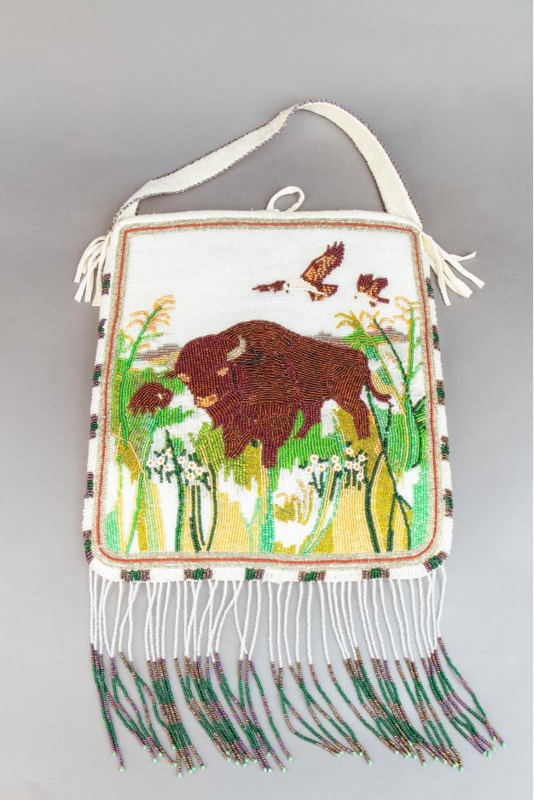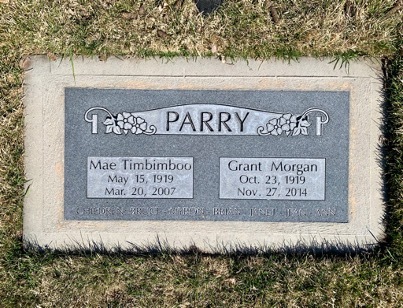Mae Timbimbo Parry

Utah State Archives Indexes, database and images, Utah State Archives, Department of Administrative Services. Division of Archives and Records Service Oaths of office, Series 17170.
Mae Timbimboo Parry was the tribal historian for the Northwestern Shoshone Tribe and preserved her tribe’s history by recording the oral histories she heard throughout her childhood. She was a gifted storyteller, a talented beadwork crafter, and an influential leader in her community.
Mae Timbimboo Parry was born May 15, 1919, in Washakie, Utah. Established in the 1880s, Washakie was a homestead for members of the Northwestern Shoshone Tribe, many of whom were descendants of survivors of the Bear River Massacre.
During her childhood, Mae attended several schools including the Sherman Institute in Riverside, California as well as the Washakie Day School, both of which were Indian boarding schools designed to assimilate Indian children into American culture. With the motto of “Kill the Indian, and Save the Man,” the schools attempted to strip Native American students of their indigenous cultures and languages in the hopes they would assimilate into mainstream American society. While attending the Washakie Day School, one of Mae’s teachers had her stand in front of class, proceeding to tell her “Mae, you are going to turn out to be just like these other children, sitting in the dirt and being useless for the rest of your life.” Contrary to her teacher’s beliefs, Mae excelled in school. She went to Bear River High School where she began to write all of the oral stories she heard growing up from her tribal leaders as well as her grandfather Da-boo-zee, or Yeager Timbimboo, who was present at the Bear River Massacre. She continued her education at LDS Business College (now called Ensign College), where she earned a degree in English.
Throughout her life, Mae continued to share the history of her tribe and was well-known for being a wonderful storyteller. She became the tribal historian and was passionate about passing the stories on to younger generations. Through her meticulous records of oral traditions, Mae was able to shift the dialogue surrounding the Bear River Massacre. Originally, the massacre was remembered as the “Battle of Bear Creek,” and her people were viewed as troublesome Indians that fought against the local militia. Mae corrected the story, showing her people were massacred despite attempts to surrender and make peace, bringing justice to her tribe.
During her time as tribal historian, Mae worked with local and federal governments to help all Native Americans. She was a representative on the White House Council for Indian Tribal Affairs where she worked with Native leaders to create and implement programs for Native Americans and distribute resources. She also served on Utah’s Indian Cooperative Council where she helped create the Native American Graves Protections and Repatriation Act, which returned Native American artifacts and human remains to their tribes. Her efforts to serve Native Americans were incredibly valuable. In 1986 she was named “Utah’s Honorary Mother of the Year” and in 1996 she received the Utah Women’s Achievement Award.
In addition to preserving her tribal history through words, Mae also carried on family tradition through her beautiful beadwork. Her grandson Darren Parry remembered her constantly working on buckskin gloves, moccasins, or other objects, carefully placing the beads to create beautiful designs.
Mae passed away on May 20, 2007 in Clearfield, Utah. Her role as teacher, storyteller, and historian preserved the history of the Northwestern Shoshone Tribe, and her legacy is continued by her grandson Darren, the current tribal historian, who continues to share her stories with the world.
Images

Utah State Archives Indexes, database and images, Utah State Archives, Department of Administrative Services. Division of Archives and Records Service Oaths of office, Series 17170.

“Shoshone Pictorial Beaded Bag.” Ca. 1988. State of Utah Alice Merrill Horne Collection, Courtesy Utah Arts & Museums.
